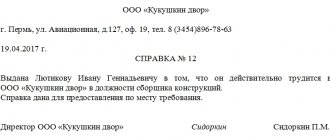A netting agreement is concluded between legal entities to control the flow of funds to repay mutual debts under sales or supply transactions. A prerequisite for concluding such a contract is the simultaneous performance by the counterparties of the contract of both the role of buyer and the role of supplier. Files in .DOC: Form of netting agreementSample of netting agreement
Conditions under which offset can be carried out
Offsetting allows you to pay for goods or services received in return.
In difficult market relations, many enterprises in the small sector of the economy experience certain problems with finances - they are often in short supply, they are invested in turnover, goods, etc., and yet it is necessary to pay off with partners. This is where mutual offset fits perfectly.
Key conditions for implementing this method of calculation:
- the presence of at least two contractual obligations in relations between companies . Moreover, according to one of them, each organization must be a creditor, according to the second, a debtor: in this way, mutual “overlapping” of debts occurs. In some cases, several enterprises participate in mutual settlements at once - the law fully allows this.
- the homogeneous nature of the obligations (for example, in the form of finances); in addition, it is necessary that certain deadlines be allocated for the offset to be completed or the possibility of demand be stipulated.
Organizations can use offset not for the entire amount of obligations, but partially, in other words, they can offset in the amount of the smallest debt. The rest can be paid in monetary terms.
Triple agreement on the offset of mutual claims: sample
A triple netting agreement is an example of a joint settlement by counterparties of debts arising under supply or service contracts in the event of a shortage of financial resources.
The conclusion of such an agreement is recognized as a transaction in accordance with the provisions of Art. 153 Civil Code of the Russian Federation, Art. 154 allows the implementation of agreements between several participants by concluding a multilateral treaty.
The basis for offset of funds is the existence of debts to each other by three organizations that agree to offset.
Tripartite agreement for the offset of mutual claims: mandatory details
Regardless of the number of parties to the contractual relationship, the document indicates a full set of mandatory details approved by the legislator for primary documentation. The tripartite netting agreement must include information about:
- names of the enterprises participating in the transaction;
- personal data of representatives of organizations that have the authority to conclude transactions and approve contracts with their signatures;
- the grounds for the emergence of powers among representatives of legal entities;
- tripartite settlement of mutual claims (sample document) requires listing the obligations of each party in relation to the counterparties participating in the transaction;
- if there are financial obligations and a desire to offset them, it is necessary to register the details of the documents on the basis of which the debt arose in the accounting;
- an agreement on the offset of mutual claims, a tripartite sample agreement must limit the period for repayment of debts - the document specifies the deadline for the implementation of debt write-off;
- the amounts of the claim that can be repaid by offset are given;
- At the end of the document form, registration information about each participant in the transaction is written down and the signatures of the responsible persons are affixed.
A tripartite netting agreement must be based on reconciliation acts between all parties. This is necessary to prevent controversial situations and subsequent legal proceedings regarding the part of the debt remaining after the offset procedure.
Triple offset of mutual claims: example of filling out an agreement
Mutual repayment of debts between counterparties without the use of non-cash and cash payments is possible subject to a number of conditions:
- the debt of all parties to the transaction can be characterized as homogeneous;
- all companies agree to set off;
- This procedure is not systematic.
Tripartite netting is possible in the following situations:
- Transaction participant “1” did not pay, a possible reason is a violation of payment terms for products that previously entered into an agreement with transaction participant “1”.
- has a receivable to enterprise “3”, the balance sheet shows the outstanding amount of payment from organization “1”.
- acts as a debtor for legal entity “1”, while simultaneously performing the role of a creditor for institution “2”.
Triple offset, subject to partial debt write-off, can be used for the following case:
- LLC "Class" owed LLC "Svoe" 50,000 rubles for goods supplied;
- Svoe LLC has an outstanding invoice from Mel LLC in the amount of 43,000 rubles;
- Mel LLC did not pay Class LLC the amount of 77,000 rubles on the agreed dates.
Triple offset for these companies is possible in the amount of the smallest debt - 43,000 rubles.
As a result, LLC “Class”, after concluding the transaction, will have to repay LLC “Svoe” a debt in the amount of 7,000 rubles (50,000-43,000), LLC “Mel” undertakes to repay the debt to LLC “Class” in the amount of 34,000 rubles (77,000- 43,000).
How to compose a paper
The netting agreement does not have a unified form, so representatives of enterprises and organizations can write it in any form or according to a model developed and approved within the company. The main thing is that the structure of this document complies with certain standards of office work; in addition, in terms of content, it must include some mandatory information.
This is important to know: Certificate of transaction size for an LLC: sample 2021
These include:
- the name of the organizations between which the agreement is being formed, their details;
- place and date of drawing up the form.
In the main part of the document it is necessary to record:
- the fact of an agreement reached;
- reference to the agreements under which it is carried out.
If there are any additional conditions or documents that are attached to this agreement, they must be noted as a separate paragraph.
Contract form
At the discretion of the parties, the form of the contract may be arbitrary depending on the requirements presented by the counterparties. The only limitations are the rules of office work. As a rule, the following circumstances and conditions are notified in the text of the contract:
- Time and place of execution of the transaction.
- Full names of organizations (enterprises) entering into the agreement.
- Passport details of authorized persons representing the interests of their organizations.
- List of debts indicating specific amounts. The register should contain references to defining the roles of counterparties as creditors or debtors. Documentary argumentation (with references to the numbers and dates of the relevant contracts) for the occurrence of debts is also necessary.
- The procedure for calculating debts. The amount to be indicated in the contract after settlements is as follows: the entire amount accepted as offset if the debts of both parties are identical; the difference in case of discrepancy between the amounts of debts to be paid to the creditor.
The final part of the agreement indicates the date of its entry into force, postal addresses and bank details of the parties to the transaction. This is followed by the signatures of authorized representatives of the parties and the seals of the organizations.
Offsetting between enterprises is quite often used in business practice, but their repeated use leads to increased attention from government control authorities.
Nuances of drawing up an agreement between organizations
Expert opinion
Kostenko Tamara Pavlovna
Lawyer with 10 years of experience. Author of numerous articles, teacher of Law
The execution of the agreement, as well as its content, is completely left to the employees of the companies. It can be written on an ordinary sheet of paper of any convenient format or on the letterhead of any organization, by hand or in printed form.
Next, the document is signed by the directors or their representatives on both sides. Signatures must be “natural”.
If organizations use seals and stamps in their activities, then the agreement form should be endorsed.
The agreement is made in two identical and equivalent copies - one for each of the interested parties. After the document is completed and endorsed, it must be registered in the document register of each company. In the future, the document serves as the basis for carrying out relevant accounting operations.
The agreement should be stored together with the contract in a separate folder for the period established by the legislation of the Russian Federation or internal regulations of companies (but not less than three years).
By whom and when is the document drawn up?
We can say that this document is very popular among organizations that are representatives of medium and small businesses.
Experience shows that these are the companies that most often experience financial difficulties. It is the act of offset that is the best option for solving money-related problems.
The act is drawn up on the basis of a statement that can be drawn up by one of the parties. At mutual request, the document may allow you to repay all or part of the debt.
If the debt is not repaid in full, it is necessary to indicate what will happen next with the remaining part. For example, the debtor company undertakes to transfer the balance of the debt to the counterparty's current account within a certain period of time.
Before drawing up the act, responsible employees of the organization verify the documents. Then the chief accountant, with the help of other authorized employees, begins to draw up an act of offset. After this, the document must be signed by the director of the company.
However, you need to know that the main condition for drawing up this act is that the obligations between the counterparties are homogeneous. For example, you can offset only services rendered, only funds, or any work performed.
If the obligations are not homogeneous, drawing up the act loses all meaning, because the document will not have legal force.
What errors might there be?
In order for an act to have legal force, no mistakes must be made when drawing it up. The most common of them are:
- Not all numbers are indicated, or the column intended to indicate VAT is missing;
- The cost is indicated only in numbers, although words are also required;
- Lack of links to documents that confirm the occurrence of debts;
- The act does not indicate that the parties agree to repay the debt in this particular way;
- Many people forget to note whether all or part of the debt is repaid;
- If the debt is not fully repaid, the date by which the debtor undertakes to repay it in full is not indicated;
- Responsible persons are indicated without position;
- There are no transcripts of the signatures.
Sometimes counterparties are faced with the question of conducting mutual offset transactions. For example, if two legal entities have entered into agreements with each other (for example, agreements for the provision of legal services), according to which they are obliged to perform certain actions in relation to each other, then counter obligations can be offset.
This is important to know: Pension for disabled children in 2021
In accordance with Article 410 of the Civil Code of the Russian Federation, obligations can be terminated either in full or in part, taking into account a counterclaim of the same type, the time period for which has either already arrived, or its period is not specified or is determined by the date of demand. For offset, an application from one of the counterparties under the agreements is required.
If the other party agrees, then an act of offset of claims is drawn up.
Cases when offset of claims is not possible in accordance with the law
1. If, at the request of one person, the claim is subject to a statute of limitations and this period has expired.
2. When compensating for harm caused to the personal health or life of an individual.
If this does not contradict the existing agreements between the parties, then, in the event of an assignment of the right of claim, the debtor has the right to set off against the claim of the new creditor his counterclaim against the original creditor. This offset is made if the claim arose on the basis that existed at the time the debtor received the notice of assignment of the right of claim, and the term of the claim came before its receipt, or this period is not specified or is indicated by the moment of the claim.
Must be observed when drawing up the act
Firstly , obligations must be only between the parties to the agreements in question; if the demand is made by a third party that is not participating in these transactions (is not a party to the agreements within the framework of which offset is carried out), then drawing up this act is impossible.
Secondly , the act must indicate only homogeneous claims, for example, monetary claims and claims of a non-material nature are not subject to offset, since in this case the claims will be of a counter nature, and therefore cannot be offset in the act.
Thirdly , the parties have the right to make the necessary mutual offset only of those obligations (demands), the calendar deadline for fulfillment of which has already arrived in accordance with the contracts under study. Such a period must be specified in the contracts, otherwise the debt obligation of one party is recognized as arising from the moment when the other party fulfilled its obligation under the contract.
In this case, the deadline for fulfilling obligations must pass.
It must be remembered that in accordance with the legislation of our country, offset of both full mutual obligations of the parties and their partial repayment is allowed. In this situation, the act must indicate the smallest amount of claims of one of the parties and a similar amount of claims of the other party.
The entire form of the netting act is in the attached file.
Sometimes there are situations when mutual loan obligations arise between organizations that need to be repaid. For this purpose, a special document was invented that allows you to write off the obligations of both parties - an act of mutual settlement between organizations.
How to register offsets with materials in a contract
The condition of homogeneity must be observed only with respect to the subject of the requirements, but not the reasons for which these requirements arose.
Before mutual settlement, one party must send a statement to the other.
It is best to do this by registered mail, and then receive a notification of delivery with a list of the attachments. Only proper registration will allow you to avoid all sorts of complications and problems.
The main settlement document in this case is the act of offset.
We are drawing up an agreement on mutual offset: what to pay attention to? When drawing up the agreement in question, the parties need to keep in mind that: 1. The agreement must necessarily reflect the following information:
- on the composition of obligations that are repaid as part of the offset;
- contracts and other documents of title (acts, invoices, invoices) under which obligations arose;
- financial value of the claims.
It is advisable to provide motivational formulations justifying its preparation. For example, indicate that the agreement is drawn up in order to simplify and increase the efficiency of calculations between the parties.
- the grounds for their occurrence (refer to contracts, primary documents, invoices) in order to confirm the reciprocity and homogeneity of obligations;
- amounts of liabilities;
- deadlines for each of them.
Thus, the parties have the right to include a corresponding condition in the contract or an additional agreement to it.
How to draw up an Act of Settlement?
The legislation does not define a strict form; it is drawn up in free form, taking into account certain requirements, in two copies for each of the parties involved. If more than two parties are involved in mutual settlements, then the number of copies must be equal to the number of participants in the act.
Each copy must contain the signatures of the managers or their substitutes of all parties involved.
If desired, managers can affix a seal (from 2021, all legal entities are exempt from the obligation to have a seal in their organization). But you need to know that many government organizations, including the Tax Service, still require certification of all documents.
In addition, the legislation establishes the presence of the following mandatory details:
- the reason for the occurrence of obligations (it is enough to indicate the details of the relevant documents);
- details of organizations that participate in the mutual settlement agreement;
- the amount of debt in digital and written terms;
- list of credit obligations that have arisen.
Copies of documents that indicate the debt has arisen must be attached to the act.
This is important to know: Application for return of loan insurance: sample 2021
How to specify payment by offset in a contract
410 of the Civil Code of the Russian Federation.
The same rule of law establishes the conditions necessary for mutual settlement between counterparties: and the counterparty declared this; If all of the above conditions are met, then the organization (IP) has the right to offset mutual claims with its counterparty. The form of such an application is not regulated, so it can be drawn up in any form.
In this case, the application must contain the mandatory details required for primary accounting documents (clause
2 tbsp. 9 of the Federal Law of December 6, 2011 No. 402-FZ “On Accounting”): The date of offset is the date the counterparty receives an application for offset of mutual claims, unless another date is indicated in the application itself. This option involves the signing of a bilateral agreement between the parties to the offset.
The agreement is drawn up in any form, and the requirements for its execution and content are the same as for the statement of offset. Despite the fact that signing a bilateral agreement may take longer than sending an application, in my opinion, this option for registering offsets is preferable. In this case, neither income nor expenses arise, since income and expenses are taken into account regardless of the fact of their payment (clause 1 of Article 272 of the Tax Code of the Russian Federation). Under the cash method, income and expenses are taken into account upon repayment of debt, including through the offset of mutual claims (clause
Under the simplified tax system, income and expenses are determined using the cash method, so the date of repayment of debt through offset will be the date of recognition of both income and expense simultaneously (clause 346.17 of the Tax Code of the Russian Federation). In this case, it is necessary to take into account the rules for recognizing certain types of expenses under the simplified tax system. For example, expenses for the purchase of goods for further sale can be taken into account only after their actual sale (clause
2 p. VAT calculated and paid to the budget from the amount of advance payment received is subject to deduction when making offsets.
Homogeneous counterclaims
Homogeneous obligations are understood as obligations that are expressed in a single currency and require the same method of repayment . Homogeneous obligations include obligations related to the fulfillment of the terms of different contracts and involving the same methods of repayment.
These can be contracts and purchase and sale agreements that are concluded between the same organizations. For example, at the stage of signing contracts, a monetary form of payment was assumed, but since all the necessary conditions were met, companies can carry out mutual settlements.
In this case, the buyer's obligations will be offset against the customer's obligations.
Important! If under one agreement the obligations are expressed in kind, and under the second - in monetary form, then it will not be possible to recognize them as homogeneous. It will also not be possible to recognize claims as homogeneous, one of which is denominated in rubles, and the other in a different currency.
Settlement is possible if the counter-obligations have the same method of repayment and are expressed in a single currency.
Example of mutual settlement between three organizations sample
Prohibition on offset between three organizations According to Article 411 of the Civil Code of the Russian Federation, offset between three organizations is not allowed in cases where we are talking about:
- compensation for harm caused to life or health;
- lifelong maintenance;
- collection of alimony;
- claims for which the statute of limitations has expired;
- other cases provided for by law or agreement.
Regulatory acts regulating the possibility of mutual settlement between the three organizations Regulatory act Scope of regulation Art. 410 of the Civil Code of the Russian Federation Termination of obligations by offset of Art. 411 of the Civil Code of the Russian Federation Cases of inadmissibility of offset Federal Law of November 21, 2011
Settlement agreement between three organizations - sample
In other words, they must have counter “debts”
- The “debts” of the parties participating in the netting agreement must be correlated with each other
- The period of time in which you need to pay off your debts has already begun. It happens that a specific period is not specified or is determined at the moment upon request
Thus, concluding all of the above, we will speak in simple language: organizations participating in a tripartite agreement must form a kind of vicious circle of their debts to each other. Do not forget that the agreement on trilateral netting should be reflected in the documents. What documents could these be:
- For example, an acceptance certificate, an agreement, a bill of lading, an extract from a banking organization, and so on.
Online magazine for accountants
The rules for conducting mutual offsets are as follows:
- This operation can be carried out by organizations between which there are two or more obligations;
- Requirements from both organizations must have the same units of measurement, for example, cash;
- Documented evidence of the occurrence of mutual obligations.
After reconciling the amounts of debts, the parties decide to sign an act of mutual settlement. The closing entry in accounting is an important rule in offsets of liabilities. Purpose of the document The main purpose of the document is to simplify the procedure for paying company bills after the expiration of the main agreement between the two companies.
Settlement agreement between three organizations - download sample
Important This partner must be notified in writing. The initiator of mutual settlements must send a registered letter with notification to the counterparty in order to have confirmation of receipt of the letter. Instructions for registration The procedure for conducting mutual settlements consists of several stages. At the first stage, the parties must identify common debts.
This is best done during a personal meeting of the responsible persons. Such communication will allow you to identify controversial issues, coordinate them and draw up a high-quality document in the shortest possible time. At the second stage, all official procedures for signing a mutual offset agreement are completed, where all requirements are specified, indicating the final amounts and the amount of VAT.
In case of unilateral mutual offset of debts, an official letter is sent.
Features of working with the act of offset
It can be presented, for example:
- cash payments in the established currency;
- supplies of certain goods in a specified quantity (certain services in a specified volume);
- transfer of promissory notes (bills of exchange) or assignment of the right to claim the debt of third parties.
That is, if the agreement between firms A and B provides for cash payments, and the agreement between firms B and C provides for natural deliveries, then offset will not be possible. 3. An agreement cannot be drawn up if (Article 411 of the Civil Code of the Russian Federation):
- at least one countable obligation is related to compensation for harm to health, lifelong maintenance, payment of alimony;
- at least one of the obligations has expired;
- there are other obstacles to its conclusion, stipulated by law or contract.
Act of mutual settlement between organizations - sample
For example, it is necessary to write off obligations between organizations “A” and “B”. “A” sends an official letter to “B” with acts of reconciliation of mutual obligations. checks, writes the answer: I agree. Lawyers prepare the contract, managers sign it, and accountants display this entry in accounting.
When netting between legal entities is impossible
Offsetting mutual claims for the following obligations is not permitted:
- for which the statute of limitations has already expired;
- which are related to compensation for damage caused to health or life;
- related to the collection of alimony;
- which are associated with the lifelong maintenance of individuals.
It is also impossible to carry out offsets if this is directly provided for by law. Also, the legislation does not allow offset if one of the parties is in bankruptcy proceedings (411 of the Civil Code of the Russian Federation).
Settlement agreement between organizations
It is advisable to reflect in the agreement the balance of debt of either party, since it is likely to arise as a result of offset. It would be appropriate to indicate in the preamble or other part of the agreement that it is drawn up on the basis of the provisions of Art.
410 and 411 of the Civil Code of the Russian Federation. Tax accounting of legal relations for the offset of obligations is characterized by the fact that: 3. When simplified, the situation is similar to that observed with the cash method of accounting for income and expenses by the payer on the SST.
Income and expenses are recognized by the company using the simplified tax system only upon the fact of offsetting obligations with the counterparty. You can download a sample netting agreement between legal entities on our website using the link below. You can learn more about the procedure for netting commercial obligations in the articles: Find out
Before mutual settlement, one party must send a statement to the other.
It is best to do this by registered mail, and then receive a notification of delivery with a list of the attachments. Only proper registration will allow you to avoid all sorts of complications and problems. The main settlement document in this case is the act of offset. Please note that the firms' obligations must be homogeneous.
They must be due for payment if it is specified in the agreement (a sample netting agreement will be given below), or the moment of payment obligation is considered the date of demand. Some illustrative examples Imagine that you rent an office in a building. The lease agreement has come to an end and you have decided not to renew it.
At the same time, the premises were renovated, a split system was installed, and parquet flooring was laid. All this was done at the expense of your company with the consent of the owner of the building.
After termination of the lease, either the owner is obliged to reimburse your repair costs, or payment may be stipulated by offset in the agreement for part of the lease payments. The contractor demanded money from the customer for the work performed.
MPZ, No. 2
- the grounds for their occurrence (refer to contracts, primary documents, invoices) in order to confirm the reciprocity and homogeneity of obligations;
- amounts of liabilities;
- deadlines for each of them.
The document must determine which obligations are repaid by offset and indicate the remaining debt of one of the parties.
However, he had a loan from a bank, and this same customer acted as a guarantor.
Reconciliation report of mutual settlements
Before legal entities proceed to netting, they should draw up a reconciliation report for mutual settlements, which contains a breakdown of each agreement. Such an act will help to accurately determine the amount of debt that can be offset.
If in the future the parties have disagreements that can only be resolved in court, then the reconciliation act will serve as documentary evidence of the mutual amounts of debt. If such a document is missing, this may lead to the offset being declared invalid.






